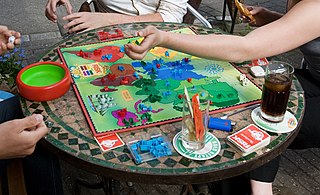
Risk is a strategy board game of diplomacy, conflict and conquest for two to six players. The standard version is played on a board depicting a political map of the world, divided into 42 territories, which are grouped into six continents. Turns rotate among players who control armies of playing pieces with which they attempt to capture territories from other players, with results determined by dice rolls. Players may form and dissolve alliances during the course of the game. The goal of the game is to occupy every territory on the board and, in doing so, eliminate the other players. The game can be lengthy, requiring several hours to multiple days to finish. European versions are structured so that each player has a limited "secret mission" objective that shortens the game.

Axis & Allies is a series of World War II strategy board games. The first version was initially published in 1981 and a second edition known colloquially as Axis & Allies: Classic was published in 1984. Played on a board depicting a Spring 1942 political map of Earth divided by territories, players take the role of one or more of the five major belligerents of World War II: the Axis powers of Germany and Japan; and the Allied powers of the Soviet Union, the United Kingdom, and the United States. Turns rotate among these belligerents, who control armies of playing pieces with which they attempt to capture enemy territories, with results determined by dice rolls. The object of the game is to win the war by capturing enough critical territories to gain the advantage over the enemy.

Conquest of the Empire is a military strategy board game set in the Roman Empire after the death of Marcus Aurelius, with 2 to 6 players pitting their armies against each other in an attempt to become the ruler of Rome. The game was created in 1982 by Larry Harris and published by The Citadel under the title VI Caesars. Harris revised the game for Milton Bradley in 1984 to be reissued under the title Conquest of the Empire as part of the Gamemaster series. The game was re-released in the summer of 2005 by Eagle Games, redesigned by Glenn Drover. The gameplay in Conquest of the Empire shares similarities to Axis & Allies, another Larry Harris project within the same series.

Axis & Allies: Europe is a strategic board wargame produced by Hasbro under the Avalon Hill name brand. Designed by Larry Harris, who designed the original Axis & Allies board game, Axis & Allies: Europe focuses game play on the European Theatre of World War II.
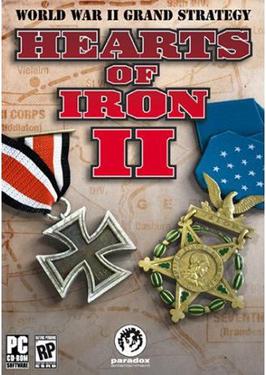
Hearts of Iron II is a grand strategy computer war game for Microsoft Windows based upon its predecessor, Hearts of Iron, which was developed by Paradox Development Studio and published by Paradox Interactive.
World in Flames is a grand strategy game on the Second World War which was first released in 1985 by the Australian Design Group, and currently holds the title of the world's largest commercially available board game. It was designed by Harry Rowland and is currently in its eighth edition, World in Flames - Collector's Edition. Each new edition features changes to the rules, maps and counters.

War at Sea is a strategic board wargame depicting the naval war in the Atlantic during World War II, published by Jedko Games in 1975, and subsequently republished by Avalon Hill in 1976 and more recently by L2 Design Group in 2007.
Attack! is a board game created by Glenn Drover and published by Eagle Games in 2003. It is a light war game that is midway between Risk and Axis and Allies in complexity. The game is loosely set in the 1930s and includes plastic pieces featuring tanks, planes, infantry, and artillery. Attack! won the Origins Award for Best Historical Game 2003.

Pacific General is a computer wargame depicting famous battles of the World War II Pacific campaigns. It was published by Strategic Simulations in 1997 using the same game engine of the earlier and successful Panzer General for Windows 95. It was re-released on GOG.com in May 2015.
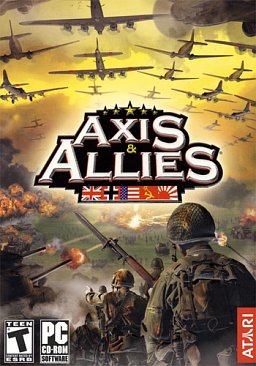
Axis & Allies is a real-time strategy World War II video game developed by TimeGate Studios and published by Atari for Microsoft Windows. The game was released on November 2, 2004. It is based on the board game series Axis & Allies from Milton Bradley and also on TimeGate's Kohan series. Set in the years after Japan and the United States entered into the war, the game allows the player to act as a World War II commander to build military forces to fight against other generals, using military units and technologies from the war. The player is able to rewrite and recreate the history of World War II.
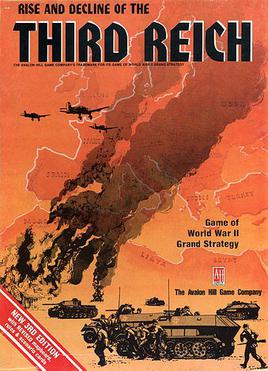
Rise and Decline of the Third Reich or more commonly Third Reich is a grand strategy wargame covering the European theater of World War II, designed by John Prados and released in 1974 by Avalon Hill. Players take on the roles of major powers—Germany, Italy, United Kingdom, France, the Soviet Union, and the United States—from 1939 to 1946.

Command & Conquer: Yuri's Revenge is an expansion pack to Command & Conquer: Red Alert 2 developed by Westwood Studios. The game was released in North America on October 9, 2001. The game is centered on a shadowy ex-Soviet figure named Yuri who has established a secret army of his own and poses a threat to the free will of the world.
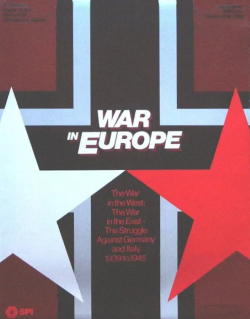
War in Europe is a grand strategic "monster" board wargame published by Simulations Publications Inc. (SPI) in 1976 that attempts to simulate the entirety of the European theatre of World War II from 1939 to 1945. One of the largest wargames ever produced, War in Europe features 4000 counters, four rulebooks, and nine maps that when placed together cover an area of 38.5 ft2. The game is nominally a three-player game, but each side can be represented by teams of players. SPI estimated the full game would take at least 180 hours.

Axis & Allies is a 1998 computer wargame closely based on the Axis and Allies: Classic board game.
Axis & Allies: Battle of the Bulge is a board game which depicts the Battle of the Bulge, the "last-ditch" offensive of World War II by Nazi Germany. It is similar to Axis & Allies: D-Day in that the game is played on a tactical rather than strategic level, although the gameplay is radically different from D-Day or any other previous Axis and Allies game. It is designed by Larry Harris, and published by Avalon Hill.

Making History: The Calm & The Storm is a World War II grand strategy video game released in March 2007 by developer Muzzy Lane. Similar in ways to the popular board games Axis & Allies and Risk, Making History is turn-based with basic industrial, economic, resource, research and diplomatic management included. The game was released as Strategic War Command in Germany.

P.T.O., released as Teitoku no Ketsudan (提督の決断) in Japan, is a console strategy video game released by Koei. It was originally released for the PC-9801 in 1989 and had been ported to various platforms, such as the X68000, FM Towns, PC-8801 (1990), MSX2 (1991), Sega Genesis and the Super NES. Players could assume one side of the Pacific Theater of Operations during World War II, acting as naval commander, organizing fleets, building new ships, appropriating supplies and fuel, and even engaging in diplomacy with other countries. The player can choose one of several World War Two battles to simulate, or could control the entire Pacific campaign well before the Japanese attack on Pearl Harbor.

Axis & Allies: Pacific 1940 is a board game created by Larry Harris and published by Avalon Hill as part of the Axis & Allies family of games. It is considered to be a revision of Harris' earlier game, Axis & Allies: Pacific. Among the major changes from Pacific was the incorporation of newer rules from newer Axis & Allies revisions, as well as features exclusive to this game.

Axis & Allies: Europe 1940 is a 2010 board wargame simulating the European Theatre of World War II at the strategic level.

Axis & Allies: World War I 1914 is a war and strategy board wargame in the Axis and Allies series created by Larry Harris and published by Avalon Hill. Unlike the other games in the Axis and Allies series, it focuses on World War I, specifically the European, African, and Near East theaters.

















